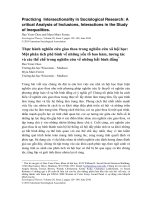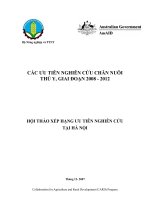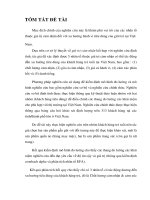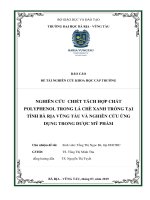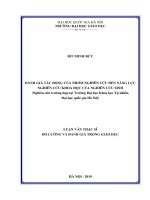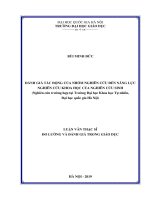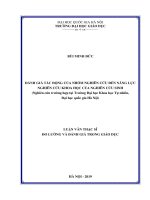Nghiên cứu các phương pháp cải tạo đất sét lòng sông sử dụng vải địa kỹ thuật - xi măng - cát
Bạn đang xem bản rút gọn của tài liệu. Xem và tải ngay bản đầy đủ của tài liệu tại đây (4.66 MB, 199 trang )
MINISTRY OF EDUCATION AND TRAINING
HO CHI MINH CITY
UNIVERSITY OF TECHNOLOGY AND EDUCATION
NGUYEN THANH TU
IMPROVEMENT METHODS TO REINFORCE
RIVERBED SILTY SOIL
USING GEOTEXTILE - CEMENT - SAND CUSHION
PH. D THESIS
MAJOR: CIVILENGINEERING
Ho Chi Minh City, 11/2023
MINISTRY OF EDUCATION AND TRAINING
HO CHI MINH CITY
UNIVERSITY OF TECHNOLOGY AND EDUCATION
NGUYEN THANH TU
IMPROVEMENT METHODS TO REINFORCE
RIVERBED SILTY SOIL
USING GEOTEXTILE - CEMENT - SAND CUSHION
MAJOR: CIVIL ENGINEERING - 9580201
Supervisor 1: Dr NGUYEN MINH DUC
Supervisor 2: Dr TRAN VAN TIENG
Examiner1:
Examiner2:
Examiner3:
Ho Chi Minh City, 11/2023
ORIGINALITY STATEMENT
I hereby declare that this is my research work.
The data and results presented in the thesis are accurate and have never been
previously published.
Ho Chi Minh City, November 26, 2023
1
ACKNOWLEDGEMENTS
ThisdissertationwascompletedattheFacultyofCivilEngineeringattheHCM
CityUniversityofTechnologyandEducationinVietnam.Thereweremanyobstacles
as
well
as
excitement during the process of completing this thesis. Without the encouragement, support, and
assistance of my advisors, colleagues, and family, I could not conduct my research.
First,Iwouldliketothankmyknowledgeableprofessors,Dr.NGUYENMINH DUC and
Dr. TRAN VAN TIENG, for admitting me as a Ph.D. student. They imparted knowledge and
taught me a great deal about not only academics but also life. Before anything else, I would
like to thank Dr. Nguyen Minh Duc for inspiring, motivating, and encouraging me to
complete thethesis.
Second, I would like to thank HCM City University of Technology and
Education, Falcuty of Civil Engineering, for the resources and equipment that
allowed me to complete my research project. In addition, I would like to thank my
coworkers for their consistent support during the implementation process.
Lastly, this dissertation is dedicated to my parents, who have always provided
me with support and encouragement.
Finally,thisthesisisamemorialtomyparents,whohavealwayssupportedand
encouraged me.
Nguyen Thanh Tu
ABSTRACT
Using silty soil that was dredged from riverbeds to replace sand for road
basementsisconsideredanalternativewithmanyadvantages.However,theriverbed soil is
soft, with low shear resistance, a high void ratio, weak permeability, and high swelling
and bearing capacity loss when saturated. Geotextile, sand cushion, and cement methods
are introduced to strengthen soil due to their popularity and effectiveness. The laboratory
experiments, including the California Bearing Ratio (CBR), a triaxial compression test,
a one-dimensional consolidation test with a modified oedometer apparatus, and a
modified direct shear test, were conducted to investigate the swelling,CBRvalue,
shear strength, and consolidation of reinforced soil. Then, evaluating the
applicability of these methods to reinforce the dredgedsoil from the Cai Lon River would be
carriedout.
With the high permeability, geotextiles accelerated the soil expansion process,
and the swell decreased by 1.3 times. In addition, theCBRvalues increased from1.1to
1.5timesfortheunsaturatedsamplesandupto3timesforthesaturatedsamples.Especially,samplesreinforcedby2layers
got
the
highestCBRvalue.
In
the
compressiontest,theshearresistanceoftheunsaturatedsamplereinforcedwiththree
triaxial
geo-
layersrosetoapproximately1.6timesthatoftheunreinforcedsoilandabout2.1 times that of
the saturated case due to the interaction between soil and geotextiles.Inthesaturatedsamples,the
porewaterpressureincreasedwhenthedisplacementwassmallbeforerapidlydecreasingwhenslippagebetweenthegeotextileandthe
soiloccurred.Inaddition,consolidationresultsindicatedthatthereinforcedsampleconsolidated1–2timesfasterthantheunreinforced
sampleofthesameheight.
In the one-dimensional consolidation test of reinforced soil, the height of the
specimen must be significant. Side friction between the soil and the ring must be
considered. A modified odometer apparatus was introduced to measure the friction
force between the soil and the ring. The results indicated that friction pressure
increasedastheratioofdiametertoheight(D/H)decreased.WhentheD/Hratiowas
lesst h a n 2 . 5 , t h e e f f e c t o f f r i c t i o n w a s s i g n i f i c a n t a n d r e d u c e d t h e c
ompression
pressurebyupto20%attheendofconsolidation(EOP).BasedontheTaylormethod, an analytical
method for predicting the stress loss and coefficient of variation of the void ratio,COV,along
soil sample depth atEOPwas proposed. The results indicated that the void ratio
increased with depth, and if theD/Hratio exceeded 2.5, theCOVwould be less
than1.2%.
When reinforced with sand cushions, the swelling, and the dried unit weight
reduction decreased with increasing sand cushion thickness. In addition,
theCBRvalue was effectively increased for saturated clay rather than unsaturated
samples.IntheUUtriaxial compression test, the shear resistance of the reinforced soil
in the unsaturated condition increased as the horizontal pressure increased. The
shear strength of unsaturated samples with a 20 mm-thick sand cushion increased
approximately 1.9 times compared to that of unreinforced samples and about 3.3
times for the saturated case. Specifically, the pore water pressure in the saturated
samples increased when the strain was small, and then the water pressure decreased.
Inaddition,theconsolidationresultsindicatedthatthereinforcedsampleconsolidates between 3.5 and
5 times faster than the unreinforcedsample.
As a binder, cement reduced the swelling of riverbed clay by 1.77 to 2.5 times
when the cement ratio increased from 3 to 10%. In the case of a 28-day saturation
curing,theCBRvalueofthesoil-cementmixtureincreasedfrom1.7to3.8timesthat of the soil.
In theUUtriaxial compression test, the shear strength of soil cement increased in
both unsaturated and saturated samples. The increase in strength of the soil cement
was due to the hydration and pozzolanic processes, which resulted in a change in
particle composition. In the case of 10% cement, the percentage of sand granules
doubled after 28 days. Brittle failure and an increase in shear resistanceandinterfaceshear
werealsoobservedbythedirectsheartestofsoilcementandthemodifiedsheartestofsoilcementandsteel.Thepeakshear
strength and residual shear resistance ofcementsoilincreased to 2.4and 1.8times those ofclay, respectively. In the case of
the interface shear strength of cement and steel, the maximalandresidualshearresistanceofcementmetalsoilswere1.55and1.40times
greater than soil-steel, respectively. Then, a formula was proposed for estimating
shear resistance over 28 days and predicting the shear strength of the soil-cement
mixture at 28 days based on the water content and cement weight.
In summary, the results indicated that the methods of reinforcing riverbed soil
with geotextile, sand cushion, and cement are effective. Based on the results, the
cement method was the most effective compared to these methods. Soil cement
mixturescanbeusedasbackfillmaterialforroadswithcartraffic,whereasgeotextile
andsandcushionscanbeusedforroadswithcar-freetraffic.Theresultsoflaboratory
formed the theoretical basis for practical applications.
experiments
TĨM TẮT
Sử dụng đất sét nạo vét từ lịng sơng thay thế cho cát san lấp nền đường giao
thông được xem là giải pháp thay thế với nhiều lợi ích. Tuy nhiên, đất từ lịng sơng
làđấtyếu,sứckhángcắtthấp,hệsốrỗngcao,tínhthấmkém,đặcbiệtlàcóđộtrương nở cao và mất
khả năng chịu lực khi bão hoà. Vải địa kỹ thuật, đệm cát và xi măng được sử dụng để gia
tăng cường độ đất do tính phổ biến và hiệu quả. Các
thí nghiệm
trongphịng,baogồmCaliforniaBearingRatio(CBR),cắt3trụctrongđiềukiệnUU, cố kết 1
trục với thiết bị cải tiến và cắt đất trực tiếp được hiệu chỉnh, được thực hiện để khảo
sát sự trương nở, cường độ và quá trình cố kết của đất và đất gia cường. Từ đó,
đánh giá khả năng áp dụng của các phương pháp gia cường này cho đất nạo vét từ
sông CáiLớn.
Vải địa kỹ thuật với tính thấm cao thúc đẩy nhanh quá trình trương nở của đất
vàđộtrươngnởgiảmđến1.3lần.Bêncạnhđó,giátrịCBRtănglêntừ1.1đế1.5lần
chotrườnghợpkhơngbãohồvàđến3lầnkhimẫubãohồ.Đặcbiệt,mẫugiacường bằng 2 lớp vải
cho giá trịCBRlớn nhất. Trong thí nghiệm 3 trục với các mẫu khơng
bãohồ,sứckhángcắttrongđiềukiệnUUcủađấtsétđượcgiacườngbằng3lớpvải tăng đến 1.6
lần so với mẫu khơng gia cường và khoảng 2.1 lần khi mẫu bão hoà do tương tác giữa đất
và vải. Trong các mẫu bão hoà, áp lực nước lỗ rỗng gia tăng khi
chuyểnvịnhỏ,saukhicósựtrượtgiữavảivàđất,áplựcnướcgiảmnhanh.Bêncạnh đó, kết quả
cố kết cho thấy, thời gian cố kết của mẫu gia cường giảm từ 1- 2 lần so với mẫu không
gia cường có cùng chiềucao.
Trongthínghiệmcốkếtmộttrụcđấtgiacường,chiềucaomẫuphảilớn.Masát thành giữa
đất và dao vịng cần phải được sét đến. Thiết bị cố kết cải tiến được giới thiệu để đo được
lực ma sát giữa đất và dao vòng. Kết quả cho thấy áp lực ma sát tăng khi tỉ lệ đường kính
và
chiều
caoD/Hgiảm.
Ảnh
hưởng
của
ma
sát
là
đáng
kể
khitỉlệD/Hnhỏhơn2.5vàáplựcnéngiảmđến20%tạithờiđiểmkếtthúcqtrình cố kết (EOP).
Dựa trên phương pháp Taylor, phương pháp giải tích được đề xuất để
dựđoánsựmấtmátứngsuấtvàhệsốsaikháchệsốrỗng,COV,dọctheochiềusâu
mẫu tại tời điểm kết thúc quá trình cố kết,EOP. Kết quả cho thấy, hệ số rỗng tăng
dần theo chiều sâu và với tỉ lệD/Hlớn hơn 2.5, giá trịCOVsẽ nhỏ hơn 1.2%.
Với phương pháp đất gia cường bằng đệm cát, độ trương nở và độ giảm trọng
lượng đơn vị khô cũng giảm khi tăng bề dày đệm cát. Bên cạnh đó, giá trịCBRđược
cảithiệnmộtcáchhiệuquảchotrườnghợpđấtbãohồhơnlàtrườnghợpđấtkhơng bão hồ.
Trong thí nghiệm 3 trục UU, sức kháng cắt trong điều kiện khơng bão hồ của đất sét
gia cường đệm cát tăng khi áp lực ngang tăng. Sức kháng cắt mẫu khơng bão hồ với
đệm cát dày 20mm tăng đến 1.9 lần so với mẫu không gia cường và khoảng 3.3 lần đối
với mẫu bão
hồ.
Đặc
biệt,
áp
lực
nước
lỗ
rỗng trong
mẫu
thí
nghiệmgiatăngkhichuyểnvịnhỏ,sauđó,áplựcnướcgiảmmạnh.Bêncạnhđó,kết quả cố kết
cho thấy, thời gian cố kết của mẫu gia cường giảm từ 3.5- 5lần.
Xi măng đóng vai trị như chất dính làm giảm độ trương nở đất lịng sơng từ
1.77 đến2.5lầnkhihàmlượngximănggiacườngtăngtừ3%đến10%,sovớitrường
hợpkhơnggiacường.Trongtrườnghợpngâmbãohồ,sau28ngày,giátrịCBRcủa xi măng
đất được gia tăng từ 1.7 đến 3.8 lần so với trường hợp đất không gia cường.
Cườngđộkhángcắtcủaximăngđấtcũnggiatăngtrongđiềukiệnnén3trụcUUkhi
mẫukhơngbãohồvàbãohồ.Sựgiatăngcườngđộcủahỗnhợpximăngđấtlàkết
quảcủaqtrìnhhydartvàpozzolaniccủaximăngvàđất,dẫnđếnsựthayđổithành phần hạt.
Kết quả sau 28 ngày cho thấy, phầm trăm hạt cát tăng lên 2 lần cho trường hợp 10% xi
măng. Sự phá huỷ giòn và sự gia tăng trong sức kháng cắt và sức kháng
masátbềmặtđượctìmthấytrongthínghiệmcắttrựctiếpđấtximăngvàthínghiệm
cắttrựctiếpbềmặtđấtximăngvàkimloại.Sứckhángcắtđỉnhvàsứckhángcắtbền của xi măng
đất tăng đến 2.4 và 1.8 lần so với đất không gia cường. Các giá trị sức kháng cắt ma sát
đỉnh và bền của đất xi măng – kim loại tăng đến 1.55 lần và 1.4 lần sovớiđấtkimloại.Từđó,cáccơngthứcđượcđềxuấtđểdựtốnsứckhángcắttheo thời gian đến 28 ngày và
dự đoán sức kháng cắt của xi măng đất tại 28 ngày theo độ ẩm và khối lượng ximăng.
Nhưvậy,cáckếtquảchothấycácphươngphápgiacườngbằngvảiđịakỹthuật,
đệmcátvàximăngcóhiệuquảtrongviệccảithiệnđấtlịngsơng.Dựatrêncáckết
quả thu được, so sánh các phương pháp, phương pháp gia cường bằng xi măng cho
hiệu quả nhất. Hỗn hợp xi măng đất có thể dùng làm nền cho đường ơ tơ, trong khi
phươngphápvảiđịakỹthuậtvàđệmcátcóthểsửdụngchođườngnơngthơnkhơng
cóơtơ.Cáckếtquảđượctrìnhbàytừcácthínghiệmởtrongphịng,làcơsởchoviệc
thựctế.
áp
dụng
TABLE OF CONTENTS
ORIGINALITYSTATEMENT...................................................................................i
ACKNOWLEDGEMENTS......................................................................................ii
ABSTRACT............................................................................................................. iii
TÓMTẮT................................................................................................................. vi
TABLEOFCONTENTS...........................................................................................ix
ABBREVIATIONandNOTATION........................................................................xiii
LISTOFFIGURES.................................................................................................xvii
LISTOF TABLES.................................................................................................xxii
CHAPTER1:I N T R O D U C T I O N ........................................................................1
1.1. AN OVERVIEW OF THERESEARCH DIRECTION:...................................1
1.2. REINFORCEDMETHODS............................................................................2
1.2.1. Geotextilereinforcement..................................................................................2
1.2.2. Sandcushionreinforcement..............................................................................3
1.2.3. Cementreinforcement......................................................................................4
1.3. THE URGENCY OFTHERESEARCH..........................................................5
1.4. SPECIFICATION OFROADEMBANKMENTS............................................6
1.4.1. Roadclassification...........................................................................................6
1.4.2. Roadembankment specifications......................................................................6
1.5. LITERATUREREVIEW................................................................................7
1.5.1. Internationalresearch.......................................................................................7
1.5.2. Nationalresearch:..........................................................................................17
1.5.3. Comments.....................................................................................................19
1.6. RESEARCHOBJECTIVES..........................................................................20
1.6.1. Goals ofthedissertation..................................................................................20
1.6.2. Researchscope...............................................................................................22
CHAPTER 2: MATERIALS – THEORIES-MODIFIEDDEVICES.........................24
2.1. MATERIAL..................................................................................................24
2.1.1. Riverbedsoil:.................................................................................................24
2.1.2. Geotextile.....................................................................................................26
2.1.3. Uniformquartsand.........................................................................................27
2.1.4. OrdinaryPortlandcement...............................................................................28
2.2. EXPERIMENTALTHEORIES.....................................................................29
2.2.1. California BearingRatioTest.........................................................................29
2.2.2. One-dimensionalconsolidationtheory............................................................30
2.2.3. Triaxial Compression Test – ModifiedTriaxialApparatus:............................32
2.2.4. Directshear test..............................................................................................38
2.3. MODIFIED SHEAR BOX FOR FRICTION BETWEEN THE
SOILANDSTEEL....................................................................................................40
2.4. MODIFIED OEDOMETER APPARATUS FOR SIDE FRICTION
PRESSUREMEASUREMENT................................................................................41
CHAPTER3:B E H A V I O R OF SILTY SOIL WITH
ANDWITHOUTGEOTEXTILE UNDER CBR, UU,
ANDCONSOLIDATIONTESTs
43
3.1. INTRODUCTION........................................................................................43
3.2. EXPERIMENTALPROGRAM....................................................................44
3.2.1. CBRspecimens..............................................................................................44
3.2.2. Unconsolidated-Undrained shear strength samples in thetriaxialtest.............45
3.2.3. Consolidationsamples....................................................................................46
3.3. BEHAVIOR OF SILTY SOIL WITH AND WITHOUT GEOTEXTILE UNDER
THE SWELLING ANDCBR TEST...........................................................................47
3.3.1. Influence of the geotextile on the behavior of thesoilswell...........................47
3.3.2. CBR behavior of unreinforced and reinforced silty soil by geotextile in unsoaked andsoakedconditions.....................................................................................49
3.3.3. The effect of soaking onCBRbehavior..........................................................51
3.4. BEHAVIOR OF SILTY SOIL WITH AND WITHOUT GEOTEXTILEONUU
SHEAR STRENGTH UNDERTRIAXIALTEST.......................................................53
3.4.1. The shear strength behavior of silty soil unreinforced and reinforced by geotextiles
in theunsaturatedcondition........................................................................................53
3.4.2. The shear strength behavior of silty soil unreinforced and reinforced by geotextiles
in thesaturatedcondition............................................................................................55
3.4.3. Shear strength reduction of silty soil and geotextile soil duetosaturation......58
3.5. CONSOLIDATION BEHAVIOR OF SILTY SOIL UNDER
EFFECTSOFSIDEFRICTION..................................................................................58
3.5.1. The one-dimensional consolidation behavior under the effects of side friction
pressure.................................................................................................................... 59
3.5.2. The total friction pressure and the friction pressureloss ratio.........................64
3.5.3. Friction between silty soil and steel, measured by a modified shear device:66
3.5.4. Modified Taylor’s method to evaluate friction pressurelossratio....................67
3.5.5. The non-uniform density in the specimens caused bysidefriction.................70
3.5.6. The coefficient ofvariation,COV....................................................................71
3.6. BEHAVIOR OF SILTY SOIL WITH AND WITHOUT GEOTEXTILE UNDER
ONE DIMENSIONALCONSOLIDATIONTEST.....................................................73
3.6.1. Primaryconsolidation....................................................................................73
3.6.2. ConsolidationcoefficientCv........................................................................................................................74
3.7. CONCLUSION............................................................................................75
CHAPTER 4: BEHAVIOR OF SILTY SOIL with and without SAND CUSHION
UNDER CBR, UU, ANDCONSOLIDATIONTEST..................................................79
4.1. INTRODUCTION........................................................................................79
4.2. EXPERIMENTALPROGRAM....................................................................79
4.2.1. CBRspecimens..............................................................................................79
4.2.2. Unconsolidated-Undrained shear strength samples in thetriaxialtest.............80
4.2.3. Consolidationsamples....................................................................................81
4.3. BEHAVIOR OF SILTY SOIL WITH AND WITHOUT SAND CUSHION
UNDER THE SWELLING ANDCBR TEST.............................................................81
4.3.1. Influence of the sand cushion on theswellbehavior.......................................81
4.3.2. The CBR behavior of unreinforced andreinforcedspecimens.........................83
4.3.3. Influences of soaking on theCBRbehavior of unreinforced and reinforced
specimens................................................................................................................. 84
4.4. BEHAVIOR OF SILTY SOIL WITH AND WITHOUT SAND CUSHION ON
UU SHEAR STRENGTH UNDER THETRIAXIALTEST........................................85
4.4.1. The shear strength behavior of silty soil reinforced with a sand cushion in the
unsaturated condition.................................................................................................85
4.4.2. The shear strength behavior of silty soil reinforced by a sand cushion in the
saturatedcondition.....................................................................................................88
4.4.3. Shear strength reduction of soil and sand cushion soil duetosaturation:........90
4.5. BEHAVIOR OF SILTY SOIL WITH AND WITHOUT SAND CUSHION
UNDER ONE – DIMENSIONALCONSOLIDATIONTEST.....................................90
4.5.1. Estimate the height and the bottom of the sand cushionunderload.................90
4.5.2. The average pressure in soil andsandcushion................................................91
4.5.3. The effect of the sand cushion on the silty soilconsolidationprocess..............94
4.6. CONCLUSION:...........................................................................................96
CHAPTER 5: BEHAVIOR OF SILTY SOIL REINFORCED BYCEMENTUNDER
CBR, UU, CONSOLIDATION, ANDSHEARTEST.................................................98
5.1. INTRODUCTION........................................................................................98
5.2. EXPERIMENTALPROGRAM....................................................................98
5.2.1. CBRspecimens..............................................................................................98
5.2.2. Unconsolidated-Undrained shear strength samples in thetriaxialtest.............99
5.2.3. Consolidationsamples..................................................................................100
5.2.4. Direct shear and interfaceshearsamples.......................................................100
5.3. BEHAVIOR OF SILTY SOIL WITH CEMENT UNDER THE SWELLING
ANDCBRTEST.....................................................................................................102
5.3.1. Influence of cement on the soil’sswellbehavior...........................................102
5.3.2. The CBR behavior of unreinforced andreinforcedspecimens.......................104
5.4. BEHAVIOR OF SILTY SOIL WITH CEMENT ON
UUSHEARSTRENGTH UNDER THETRIAXIALTEST......................................105
5.4.1. The shear strength behavior of unsaturated soil reinforcedbycement:.........105
5.4.2. The shear strength behavior of silty soil reinforced by cement in the saturated
condition................................................................................................................108
5.4.3. Shear strength reduction of silty soil and cemented soil due tosaturation:.109
5.5. BEHAVIOR OF SOIL CEMENT UNDERCONSOLIDATIONTEST........110
5.6. GRAIN SIZE DISTRIBUTION OF SOILCEMENTMIXTURE.................114
5.7. INTERFACE SHEAR STRENGTH BEHAVIOR OF CEMENT- TREATED
SOIL UNDER CONSOLIDATEDDRAINEDCONDITIONS...............................118
5.7.1. Shear stress-strain behavior of cement stabilized soil under consolidateddrainedconditions...................................................................................................118
5.7.2. Behaviorofinterfaceshearstrengthbetweencement-treatedsiltysoilandsteel
underconsolidated-drainedconditions......................................................................119
5.7.3. Resultoftheeffectofcementcontentontheshearstrengthandinterfaceshear strength
ofcement-treatedsoil...............................................................................................121
5.7.4. Effect of the curing period on the shear strength and the interfaceshearstrength
ofcement-treatedsoil...............................................................................................128
5.8. CONCLUSION..........................................................................................130
CHAPTER 6: CONCLUSIONSandRECOMMENDATIONS..............................133
6.1. COMPARISON..........................................................................................133
6.2. CONCLUSION..........................................................................................137
6.3. LIMITATIONSANDRECOMMENDATIONS:.........................................138
REFERENCES......................................................................................................139
LISTOF PUBLICATIONS....................................................................................150
ABBREVIATION AND NOTATION
ABBREVIATION:
UU
: Unconditioned- UndrainedCondition
CU
: Consolidated- UndrainedCondition
CD
: Consolidated- Drained Condition
CBR
: California BearingRatio
EOP
: The end ofconsolidation
COV
: Coefficient of variation of voidratio
USCS
: Unified Soil ClassificationSystem
DMM
: Deep MixingMethod
LVDT
: A linear variable differentialtransformer
CL
: Low plasticityclay
CH
: High plasticity clay (Fatclay)
MH
: High plasticitysilt
NOTATION
Basic SI units are given in parentheses.
D
: Diameter of a sample(m)
H0
: The initial height of a sample(m)
H
: The height of a sample at the end of primary consolidation(m)
e
: Void ratio of soil(dimensionless)
P
: The compression pressure due to external forces(Pa)
Paverage
: The average consolidation pressure(Pa)
R
: Thereactionpressuremeasuredatthebottomofthespecimens(Pa)
z
: The depth from the top of soil sample(m)
tz
: Interface shear stress at the depthzof soil(Pa)
Pz
: average consolidation pressure at the depthzof soil(Pa)
eP
: Void ratio at the top soil layer(dimensionless)
eR
: Void ratio at the bottom soil layer(dimensionless)
eEOP
: Void ratio at the end of consolidation(dimensionless)
PL
: Plastic limit(%)
PI
: Plastic index(%)
LL
: Liquid limit(%)
Gs
: Specific gravity(dimensionless)
: Moisture unit weight(N/m3)
D50
: median particle size(m)
D10;D30;D60
d
: the diameter of a particle whose diameter is smaller
thanthat,accounts for 10%, 30%, 60% of the total weight,
respectively(m)
: Dry unit weight(N/m3)
S
: the swelling of soil(%)
S96h
: The percent swell after 96 hours of soaking(%)
s
: Vertical swell(m)
CBR1,CBR2
: CBRat 2.54 mm and 5.09 mm of penetration,respectively
RCBR
: The strength ratio was the ratio of theCBRof the reinforced
specimen to that of the unreinforced specimen(dimensionless).
: Valueofpressureinpiston(MPa)at2.54mmand5.09mminCBR test, in
turn(Pa)
: Compression pressure in soil(Pa)
1
: The vertical (longitudinal) compression pression(Pa)
2,3
: The horizontal compression pression(Pa)
U
: Pore water pressure(Pa)
: Increasement of compression pressure in soil(Pa)
u
: Increasement of pore water pressure in soil(Pa)
Cc
: Compression index(dimensionless)
Cv
: Coefficient of consolidation(m2/s)
Hdrainage
: The length of the drainage route(m)
T100;T90;T50
: Time related to the specific degree of consolidation (100%, 90%
and 50% of consolidation)(second)
: Elastic modulus(Pa)
P1; P2
E
: Axial strain(%)
ΔHH
: Soil settlement(m)
A
: Cross-sectional area(m2)
A1
: The average cross-sectional area due to lateral expansion(m2)
c
: The cohesion of soil(Pa)
: Internal friction angle of soil(degree)
int
: Interface friction angle between the clay and the steel(degree)
Kp
: Passive earth pressure coefficient (dimensionless).
Su
: Shear strength in the UU triaxial test of saturated samples(Pa)
hgeo
: The geotextile spacing (m)
Dpiston
: the diameter of the load piston inCBRtest(m)
Ruf
Tshear
: The shear strength increasement in the unsaturated condition
duetoreinforcement(dimensionless).
: The shear strength increasement in the saturated condition
duetoreinforcement(dimensionless).
: Shear strength reduction due to saturation(%)
K0
: The horizontal expansion coefficient of soil(dimensionless).
P0
: The pre-consolidation pressure (Pa)
sd_Po
: the standard deviation of the pre-consolidation pressure(Pa)
hsand
: The height of sand cushion at EOP
(m)Pb_sand
: the bottom pressure of the sand cushion
(Pa)Pt_sand
: the top pressure of the sand cushion(Pa)
Cc_sand
: compression index of the sand (dimensionless)
Rf
Po_sand
e0_sand
pre-consolidation pressure of sand at the void ratio e0_sand(Pa)
: the void ratio of sand at the pre-consolidation
pressure(dimensionless).
Ho_sand
: The initial height of the sand cushion(m)
K0_sand
: the coefficient of the sand cushion at rest(dimensionless).
’Int_sand
: interface friction angle between sand and ring(degree)
Pave_soil
: The average pressures at the center of all the soil (Pa)
losspressure
: The loss pressure due to side friction(degree)
SD_H/H
: factional error of estimated height(%)
SD_P/Po_average
:
factional error of pre-consolidation pressure(%)
SD_e
: The standard deviation of the void ratio(dimensionless)
r
: The reduction due to side friction(dimensionless)
H’
: The height of specimens at EOP without side friction effects(m)
: The height factor accounts for the effects of side friction.
(dimensionless)
cm
: Cement content(%)
Rs
: shear strength ratio of soil-cement mixture(dimensionless).
IEF
: interface efficiency ratio(dimensionless)
qu
: the unconfined compressive strength of cement-treated soil(Pa)
LIST OF FIGURES
Figure 1.1: Geotextile and soil reinforced by a layerofgeotextile.............................3
Figure 1.2: Soil reinforced by asandcushion..............................................................4
Figure 1.3: The appearance of soil-cement as abase [1].............................................5
Figure 1.4: The laboratory experiments inthis study.................................................22
Figure 2.1: Grain size distribution ofthesoil............................................................25
Figure 2.2: Construction diagram for drying mud according to methods (a)
conventional drying method; (b) a layer ofsandcushion...........................................25
Figure 2.3: Process ofrecyclingsoil..........................................................................25
Figure 2.4: The settlement of a geotextile layerunderpressure.................................26
Figure 2.5: Sand'sgrain-sizedistribution.....................................................................27
Figure 2.6: The settlement of a 5-, 10-, and 20-mm sand cushionunderpressure.......28
Figure 2.7: Mold with extension collar andspacerdisc.............................................29
Figure 2.8: Change of pore water pressure during theconsolidationprocess..............31
Figure 2.9:One-dimensionalschematic.....................................................................31
Figure 2.10: A modified triaxialcompression aparatus...............................................34
Figure 2.11: Directshearapparatus............................................................................39
Figure 2.12: Modified shear box for interfaceshearstrength.....................................40
Figure2.13:Modifiedoedometerapparatusforsidefrictionpressuremeasurement
...................................................................................................................................41
Figure 3.1: Geotextile layers in reinforced and unreinforcedCBRspecimens...........44
Figure 3.2: Geotextile layers in reinforced and unreinforced samples in theUUtest.
...................................................................................................................................45
Figure 3.3: Uninforced and geotextile-reinforced samples in UUthetest.................45
Figure 3.4: Samples to investigatesidefriction.........................................................46
Figure 3.5: Samples reinforced by geotextile inone-dimension consolidation...........46
Figure 3.6: Percent swelling of soil and geotextile-soil specimens during soaking.47
Figure3.7:Theswellvelocity(a)duringtheinitial20hoursand(b)after20hours
...................................................................................................................................48
Figure 3.8: The piston stressvs. penetration..............................................................49
Figure 3.9: The relationship between strength ratio andgeotextilespacing................50
Figure 3.10: Deviation stress versus axial strain of
unreinforcementandreinforcement with geotextile in theunsaturatedcondition.........53
Figure 3.11: The vertical versus lateral pressure of silty soil and geotextile soil at
failure inunsaturatedcondition..................................................................................54
Figure 3.12: Shear strength increasement versus lateral pressure in the unsaturated
condition.................................................................................................................. 55
Figure 3.13: The deviation stress and axial strain of soil and soil reinforced by
geotextile in thesaturatedcondition...........................................................................56
Figure3.14:Theexcessporewaterpressureandaxialstrainofsoilandsoilreinforced by geotextile in
thesaturatedcondition................................................................................................56
Figure 3.15: The shear strength increasementRfand excess pore water pressureofsoil
and soil reinforced by geotextile in thesaturatedcondition...........................................57
Figure 3.16: Shear strength reductionTsheardue to saturation of silty soil with
andwithoutgeotextile................................................................................................58
Figure 3.17: Axial strain vs. time under 99.5kPa ofcompressionpressure.................59
Figure 3.18: Variation of time corresponding to 100% primary
consolidation,T100,with square maximum drainage distance,Hdrainage2, under different
compressionpressures.Theemptyandsolidsymbolsindicatethespecimenswitha50mmand
75 mmdiameter,respectively......................................................................................60
Figure3.19:Consolidationcoefficientvaluewiththeaverageconsolidationpressure.
...................................................................................................................................61
Figure3.20:Compressioncurves(eEOPlogP)withoutpressurecorrectionforfrictionpressureloss..............................................62
Figure 3.21: Compression curves (eEOP-logPaverage) of soil specimens after
pressurecorrection for frictionpressureloss...............................................................63
Figure 3.22: The estimated pre-consolidation pressure with fractionalerror/64
Figure 3.23: The temporal variation of totalfrictionpressure....................................64
Figure3.24:Thefrictionpressurelossratioattheendoftheprimaryconsolidation.
...................................................................................................................................65
Figure3.25:Interfaceshearstrengthbehaviorandfailureenvelopesofshearstrength and
interface shear strength under differentnormalpressures...............................................66
Figure 3.26: Non-uniform void ratio condition caused by side frictionatEOP.........68
Figure 3.27: Comparison between the experimental and predicted height of soil
specimens atEOPusing theheightfactor....................................................................69
Figure 3.28: Comparison between the measured and predictedvoidratio.................71
Figure 3.29: The variation of void ratio with the depth with the diameter (a)D=
75mm and (b)D= 50m under the compression pressure,P=99.5kPa........................71
Figure 3.30: Variation ofCOVwith the compression pressure on the top of
soilspecimens with differentratioD/H0.............................................................................................................72
Figure 3.31: Variation ofCOVwith the friction loss ratio atEOPof soil specimens
obtained fromdifferent studies..................................................................................73
Figure 3.32: The required time to obtain a) 100% (T100) and b) 90%
(T90)consolidation ofgeotextilesamples....................................................................74
Figure 3.33: The consolidation coefficientsCvvs. average pressure of geotextile
soilsamples..............................................................................................................75
Figure 4.1: The arrangement of the sand cushion with varied thickness reinforced
CBR specimens in unsoaked andsoakedconditions..................................................80
Figure 4.2: The arrangement of sand cushions in theUUtest....................................80
Figure 4.3: The sand cushion specimens in theUUtest.............................................80
Figure 4.4: Samples reinforced by sand cushions in one-dimensionalc o n s o l i d a t i o n
...................................................................................................................................81
Figure 4.5: Swell behavior with time of unreinforced and reinforced specimens (a)
percent swell and (b) velocityofswell......................................................................81
Figure4.6:Correctedstressinthepistonofthespecimen(a)withoutsoakingand(b)
soakingcondition.......................................................................................................83
